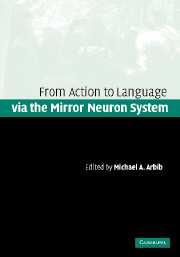Book contents
- Frontmatter
- Contents
- List of contributors
- Preface
- Part I Two perspectives
- Part II Brain, evolution, and comparative analysis
- Part III Dynamic systems in action and language
- Part IV From mirror system to syntax and Theory of Mind
- 9 Attention and the minimal subscene
- 10 Action verbs, argument structure constructions, and the mirror neuron system
- 11 Language evidence for changes in a Theory of Mind
- Part V Development of action and language
- Index
- References
10 - Action verbs, argument structure constructions, and the mirror neuron system
Published online by Cambridge University Press: 01 September 2009
- Frontmatter
- Contents
- List of contributors
- Preface
- Part I Two perspectives
- Part II Brain, evolution, and comparative analysis
- Part III Dynamic systems in action and language
- Part IV From mirror system to syntax and Theory of Mind
- 9 Attention and the minimal subscene
- 10 Action verbs, argument structure constructions, and the mirror neuron system
- 11 Language evidence for changes in a Theory of Mind
- Part V Development of action and language
- Index
- References
Summary
Introduction
This chapter reviews recent evidence that the linguistic representation of action is grounded in the mirror neuron system. Section 10.2 summarizes the major semantic properties of action verbs and argument structure constructions, focusing on English but also considering cross-linguistic diversity. The theoretical framework is Construction Grammar, which maintains that the argument structure constructions in which action verbs occur constitute basic clausal patterns that express basic patterns of human experience. For example, the sentence She sneezed the napkin off the table exemplifies the Caused Motion Construction, which has the schematic meaning “X causes Y to move along path Z,” and the sentence She kissed him unconscious exemplifies the Resultative Construction, which has the schematic meaning “X causes Y to become Z” (Goldberg, 1995).
Section 10.3 addresses the neuroanatomical substrates of action verbs and argument structure constructions. A number of neuroimaging and neuropsychological studies are described which suggest that different semantic properties of action verbs are implemented in different cortical components of the mirror neuron system, especially in the left hemisphere: (1) motoric aspects of verb meanings (e.g., the type of action program specified by kick) appear to depend on somatotopically mapped primary motor and premotor regions; (2) agent–patient spatial–interactive aspects of verb meanings (e.g., the type of object-directed path specified by kick) appear to depend on somatotopically mapped parietal regions; and (3) visual manner-of-motion aspects of verb meanings (e.g., the visual movement pattern specified by kick) appear to depend on posterior middle temporal regions.
- Type
- Chapter
- Information
- Action to Language via the Mirror Neuron System , pp. 347 - 373Publisher: Cambridge University PressPrint publication year: 2006
References
- 25
- Cited by



